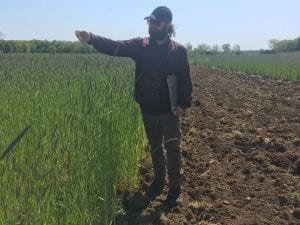Bryan Brown, Marcus Lopez, Abby Seaman
A lot. But looking at our stand of rye in April 2021, we were worried by how unimpressive it was. In New York, cereal rye biomass at anthesis can hit levels of 3,500 lbs/A when unfertilized and 7,000 lbs/A with fertilizer. But with more fertility, you risk the rye growing too leggy and lodging.
We had planted the rye (cv Aroostook) on 9/17/20 at 168 lbs/A. We thought we had plenty of fertility from the previous summer’s cover crop of sudangrass. And a soil test on 10/29/20 showed “very high” phosphorous, and “high” potassium, calcium, and magnesium. So we didn’t see a need to fertilize. But it seems like the nitrogen is tied up in the decomposition and wasn’t being made available as early as we hoped.
In May, our rye put on some serious growth (see Marcus standing next to the rye). At anthesis, the same day we roller-crimped it, we collected and dried samples of our rye crop and it averaged out to about 3,100 lbs/A. Bummer. Not as much as we had hoped.
For comparison, in vegetables, straw or hay mulch is recommended at about 18,000 lbs/A to provide season-long weed free conditions. But in more competitive crops like soybeans, I’ve shown that around 7,000 lbs/A can provide satisfactory weed control (87%) and that even 3,500 lb/A provided 73% control.
Unfortunately, our winter squash isn’t going to close canopy like soybeans. And since we had to keyline plow a slot for the squash to root into (and allow our waterwheel transplanter to work) that 4” band of disturbed soil is already sprouting some common ragweed. So, as of June 10, 2021, this treatment is already starting to falter and we haven’t even planted yet. Perhaps for next year, we’ll fertilize the rye, direct seed, and have no need to keyline plow…

